Research on Electromagnetic Susceptibility of Electronic Modules in Component-Level HEMP PCI Test
Abstract
1. Introduction
2. Vulnerability of the Test VHF Wireless Communication System
2.1. The VHF Wireless Communication System and Vulnerability Analysis
2.2. Problem Description
3. Component-Level PCI Tests of LNA and Data Analysis
3.1. The LNA and the PCI Test Method
3.2. Result after PCI with Different Pulses
4. Mechanism Analysis on the Damage of the LNA
4.1. Mechanism for the Damage of the LNA
4.2. Waveform Equivalence and EM Parameter Determination
5. Conclusions
Author Contributions
Funding
Conflicts of Interest
References
- Giri, D.V.; Hoad, R.; Sabath, F. High-Power Electromagnetic Effects on Electronic System; Artech House: London, UK, 2020; pp. 1–50. [Google Scholar]
- Giri, D.V.; Tesche, F.M. Classification of intentional electromagnetic environments (IEME). IEEE Trans. Electromagn. Compat. 2004, 46, 322–328. [Google Scholar] [CrossRef]
- Mao, C.; Canavero, F. System-level vulnerability assessment for IEMI: From fault tree analysis to Bayesian networks- Part I: Methodology framework. IEEE Trans. Electromagn. Compat. 2016, 58, 180–187. [Google Scholar] [CrossRef]
- Mao, C.; Canavero, F.; Cui, Z.; Sun, D. System-level vulnerability assessment for IEMI: From fault tree analysis to Bayesian Networks-Part II: Illustration to microcontroller system. IEEE Trans. Electromagn. Compat. 2016, 58, 188–196. [Google Scholar] [CrossRef]
- Cui, Y.; Zhang, Y.; Wang, Z.; Fu, H.; Mao, X. Interval statistic-based reliability analysis method on small sample hot test of satellite thruster. Appl. Math. Modeling 2018, 60, 581–591. [Google Scholar] [CrossRef]
- Zhang, S.F.; Yang, H.B.; Zhang, J.H. Reliability assessment methods with small-sample for device with only safe-or-failure pattern. Nucl. Power Eng. 2006, 27, 79–83. [Google Scholar]
- Dinkar, B.K.; Mukhopadhyay, A.K.; Chattopadhyaya, S.; Sharma, S.; Alam, F.; Machado, J. Statistical reliability assessment for small sample of failure data of dumper diesel engines based on power law process and maximum likelihood estimation. Appl. Sci. 2021, 11, 5387. [Google Scholar] [CrossRef]
- Bourinet, J.M.; Mattrand, C. Damage tolerance and reliability assessment under random Markovian loads. Procedia IUTAM 2013, 6, 123–131. [Google Scholar] [CrossRef][Green Version]
- Bee, S.; Leferink, F. Vulnerability of remote keyless-entry systems against pulsed electromagnetic interference and possible improvements. IEEE Trans. Electromagn. Compat. 2016, 58, 1259–1265. [Google Scholar]
- Camp, M.; Garbe, H. Susceptibility of personal computer systems to fast transient electromagnetic pulses. IEEE Trans. Electromagn. Compat. 2006, 48, 829–834. [Google Scholar] [CrossRef]
- Pan, X.; Wei, G.; Lu, X.; Wan, H.; Fan, L. Equivalent simplification method of complex transient injection waveform. High Volt. Eng. 2017, 43, 1736–1744. (In Chinese) [Google Scholar]
- IEC 61000-2-10; Electromagnetic Compatibility (EMC): Part 2-10. Environment-Description of HEMP Environment-Conducted disturbance; IEC: Geneva, Switzerland, 1998.
- Ianoz, M.; Nicoara, B.I.C.; Radasky, W.A. Modeling of an EMP conducted environment. IEEE Trans. Electromag. Compat. 1996, 38, 400–413. [Google Scholar] [CrossRef]
- Baum, C.E. Norms and Eigenvector Norms. AFWL Math. Notes 1979, 63, 1–42. [Google Scholar]
- IEC 61000-2-9; Electromagnetic Compatibility (EMC): Part 2. Environment-Section 9: Description of HEMP Environment-Radiated Disturbance; IEC: Geneva, Switzerland, 1996.
- Coburn, W.O.; Nguyen, E.; Reyzer, R.J.; Mar, M.H. High-Altitude Electromagnetic Pulse Survivability Assessment of the Harris RF-3200 Transceiver; ADA258347; Harry Diamond Labs: Adelphi, MD, USA, 1992. [Google Scholar]
- Du, C.B.; Mao, C.G.; Sun, D.; Zhang, X. Effect Characterization and Modeling of RF Low Noise Amplifier for VHF communication System after HEMP PCI Test. In Proceedings of the 2020 IEEE MTT-S International Conference on Numerical Electromagnetic and Multiphysics Modeling and Optimization (NEMO) IEEE, Hangzhou, China, 7–9 December 2020. [Google Scholar]
- MIL-STD-188-125-2; High-Altitude EMP Protection for Fixed Ground-Based Facilities; United States Department of Defense: Washington, DC, USA, 1999.
- RF3376 Datasheet. Available online: https://html.alldatasheetcn.com/html-pdf/155390/RFMD/RF3376/95/1/RF3376.html (accessed on 28 December 2021).
- MIL-STD-188-125-1; High-Altitude EMP Protection for Fixed Ground-Based Facilities; United States Department of Defense: Washington, DC, USA, 1999.
- IEC 61000-4-33; Electromagnetic Compatibility (EMC): Part 4-33. Testing and Measurement Techniques-Measurement Methods for High-Power Transient Parameters; IEC: Geneva, Switzerland, 2005.
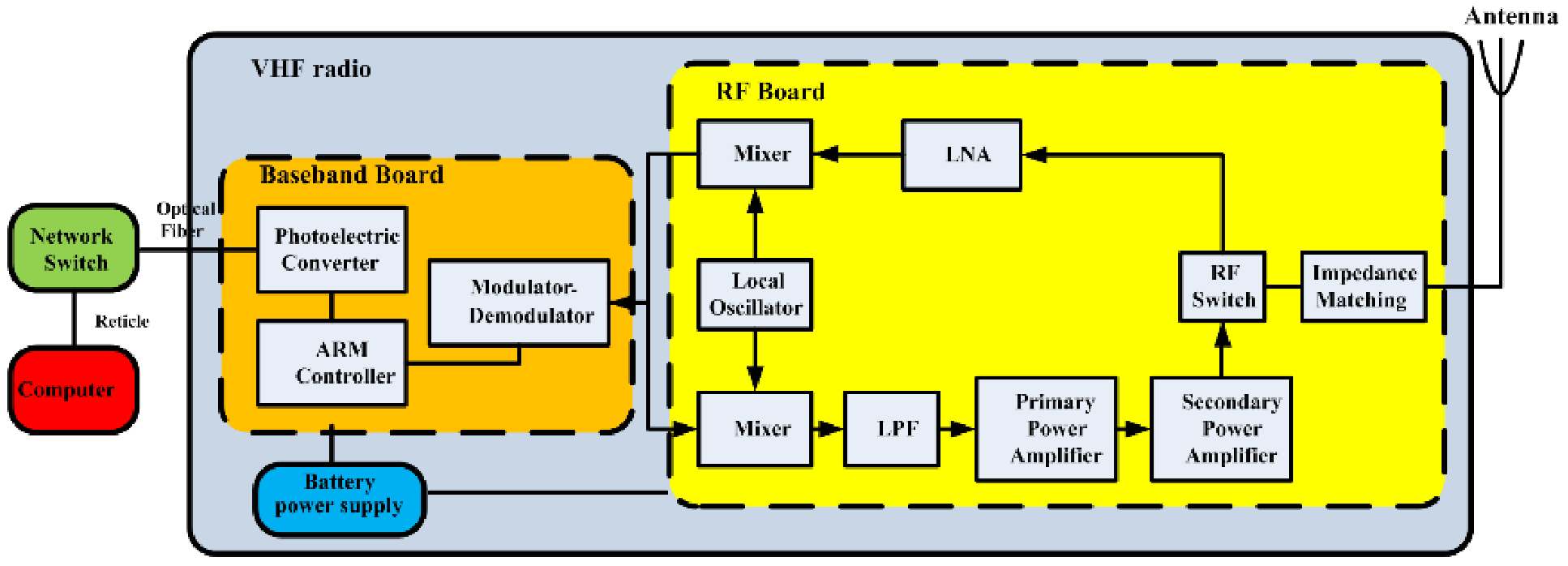
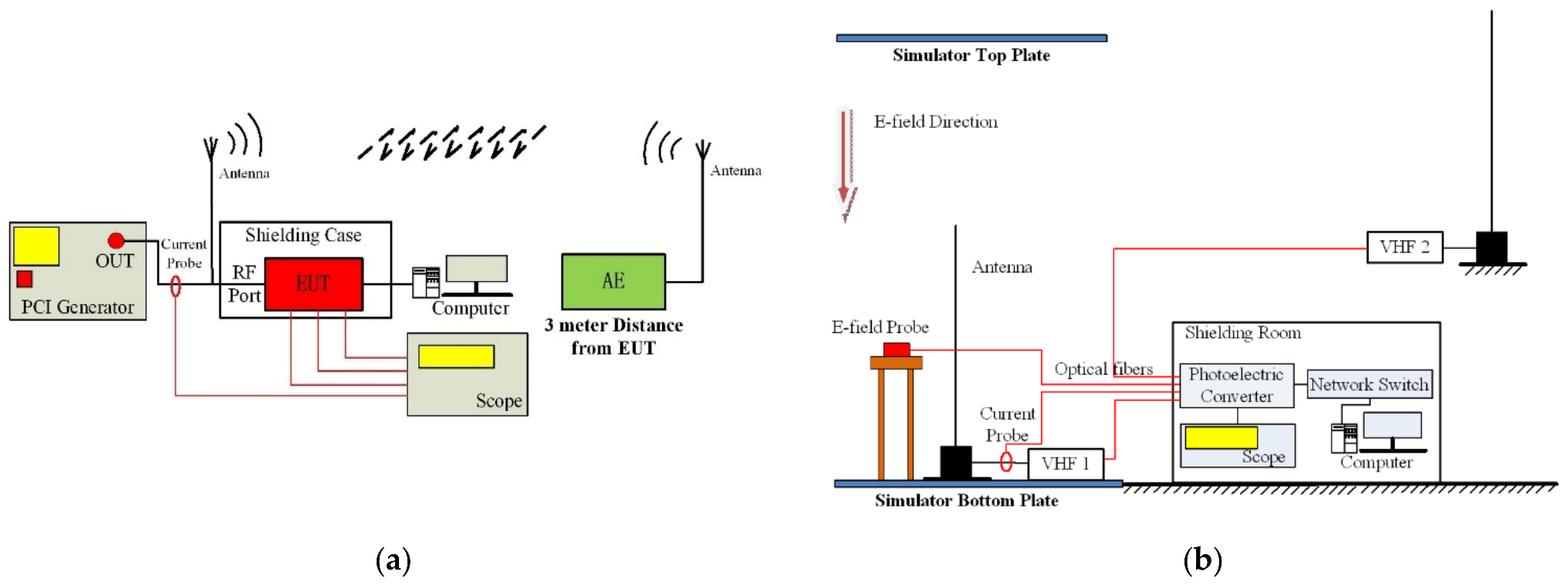
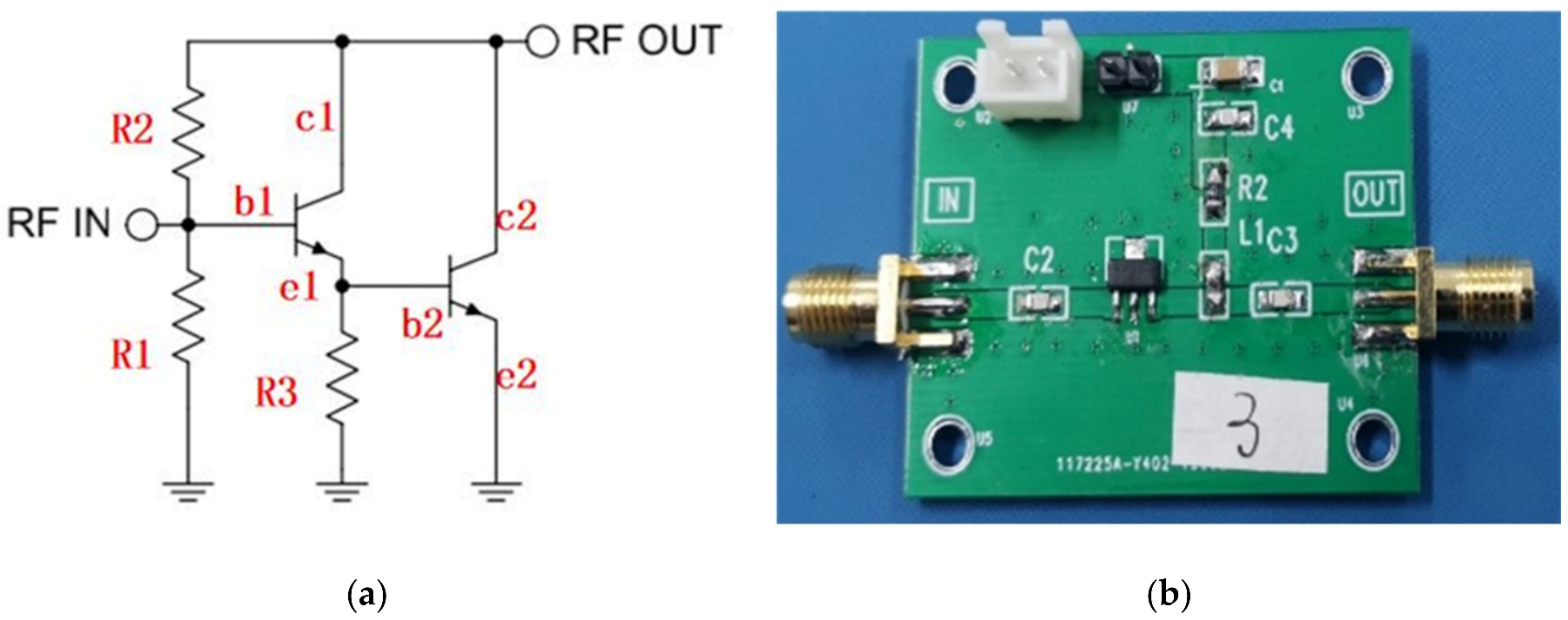
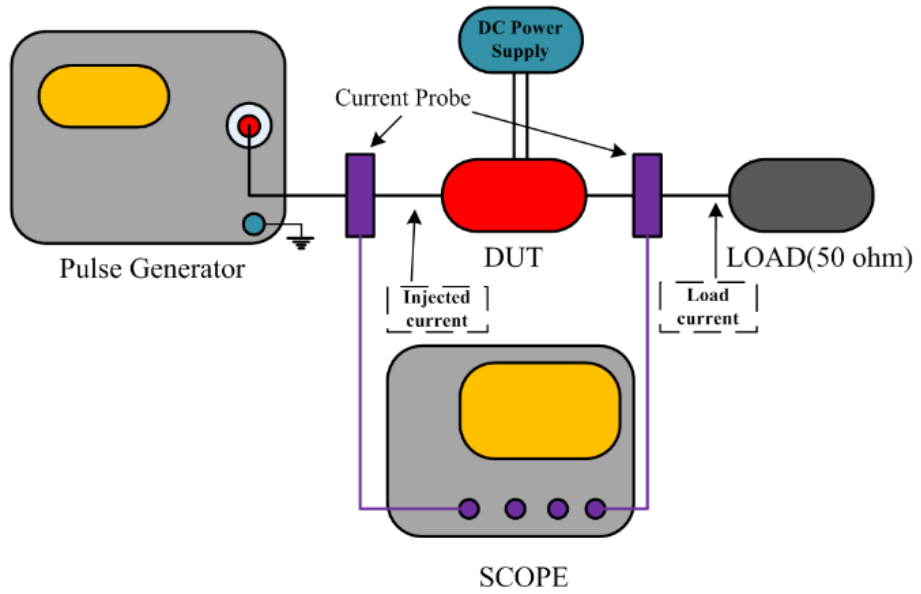
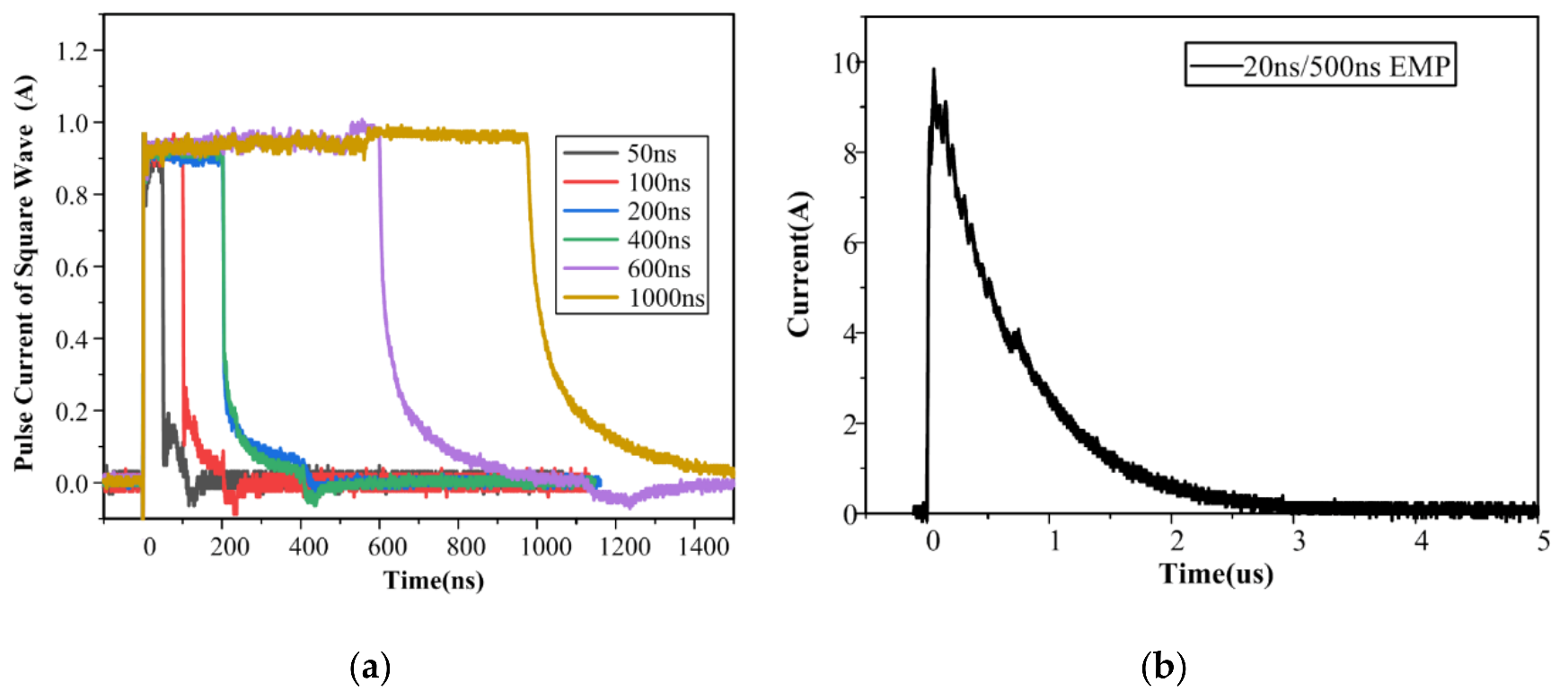
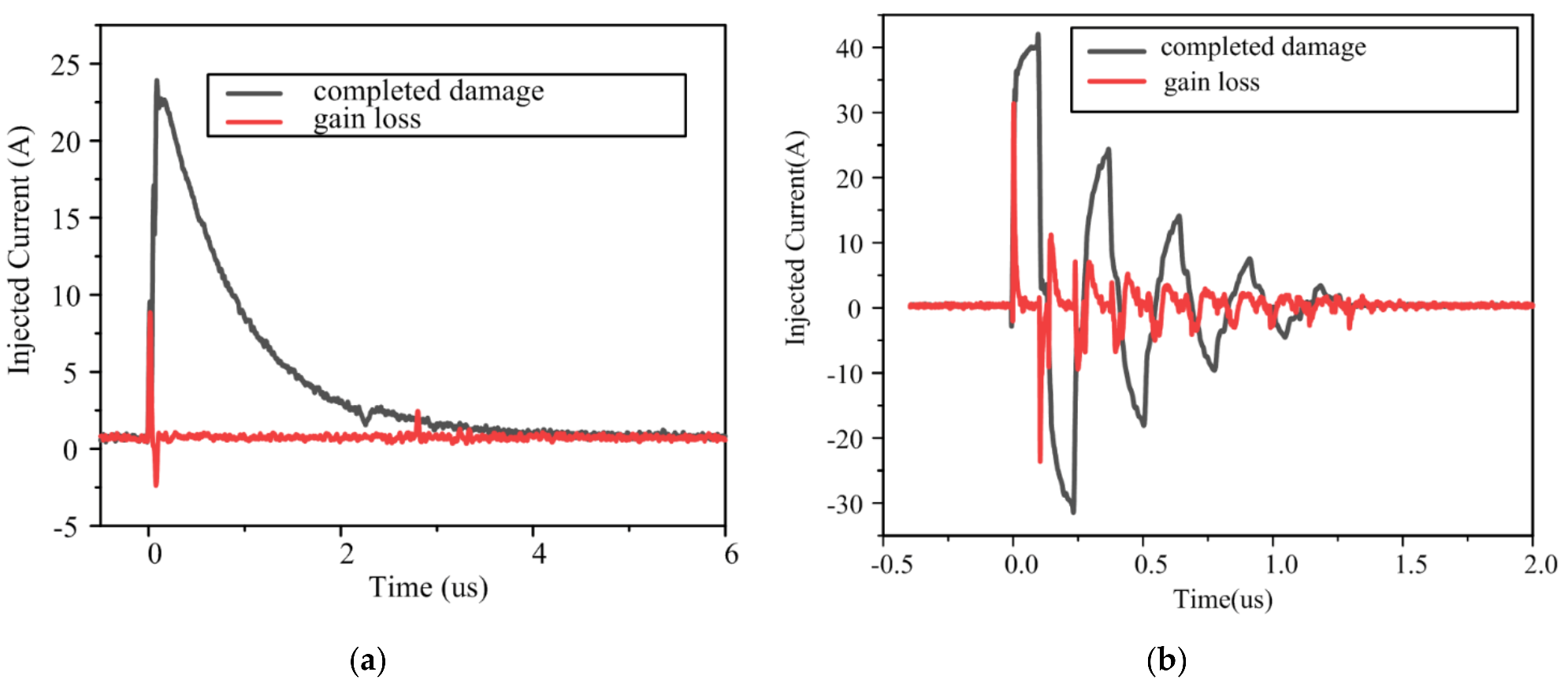
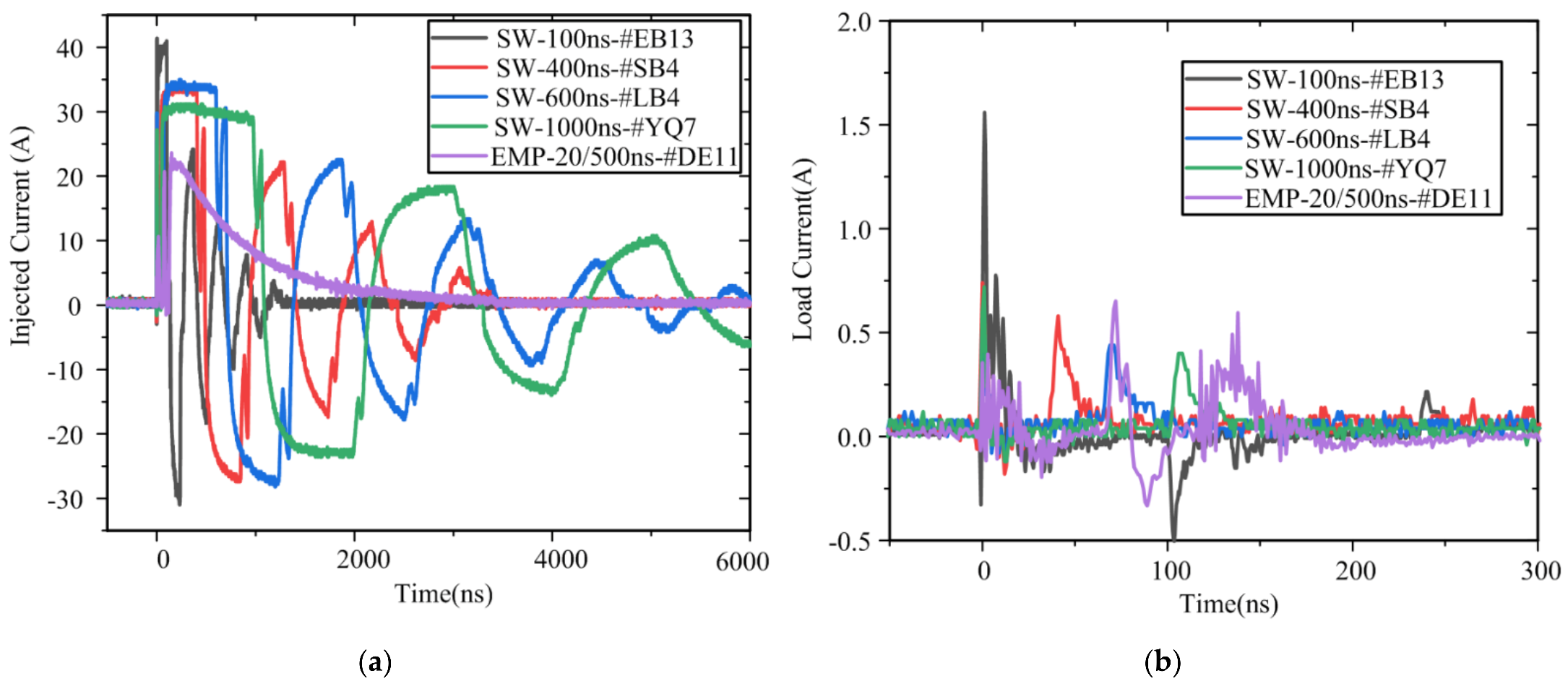
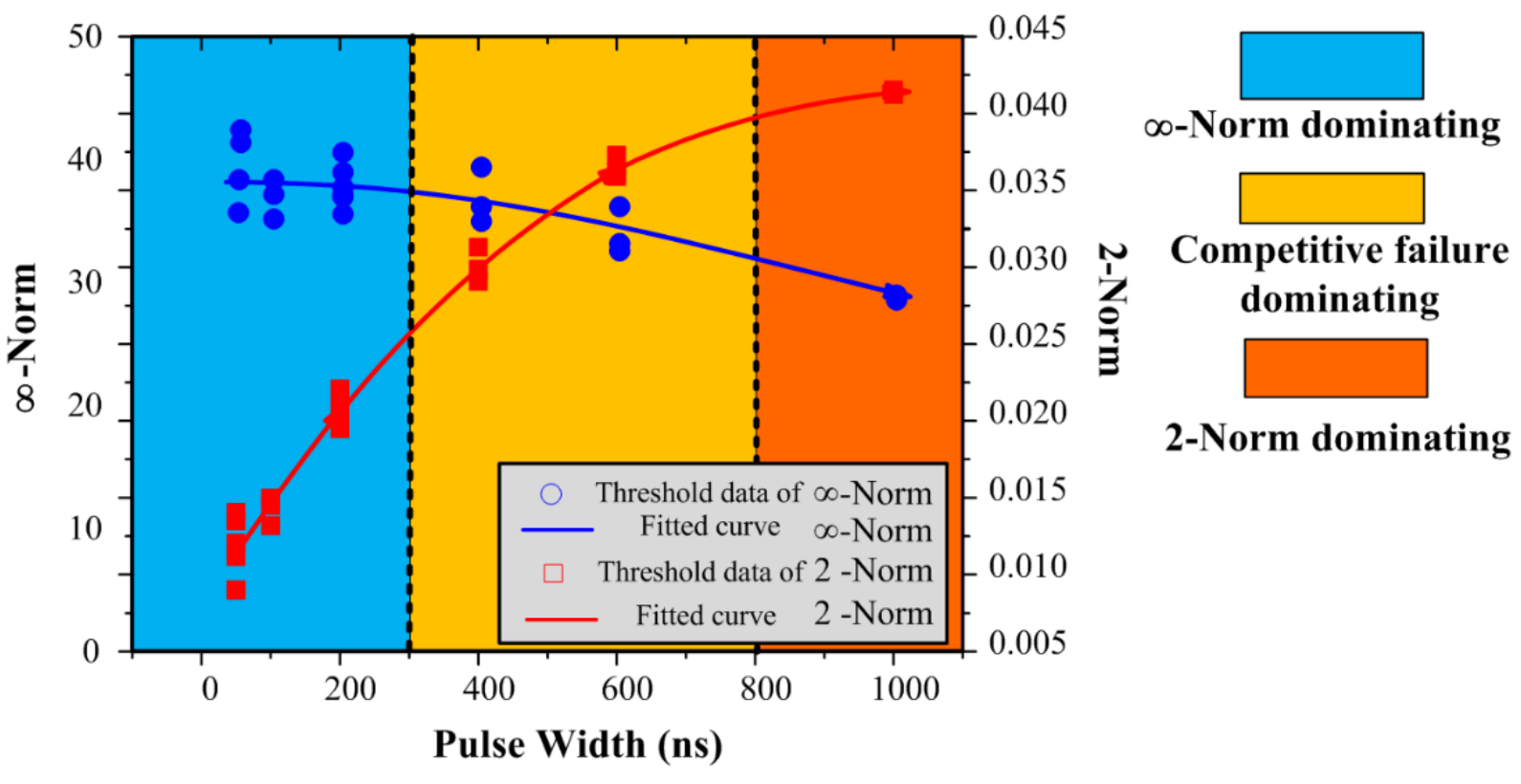
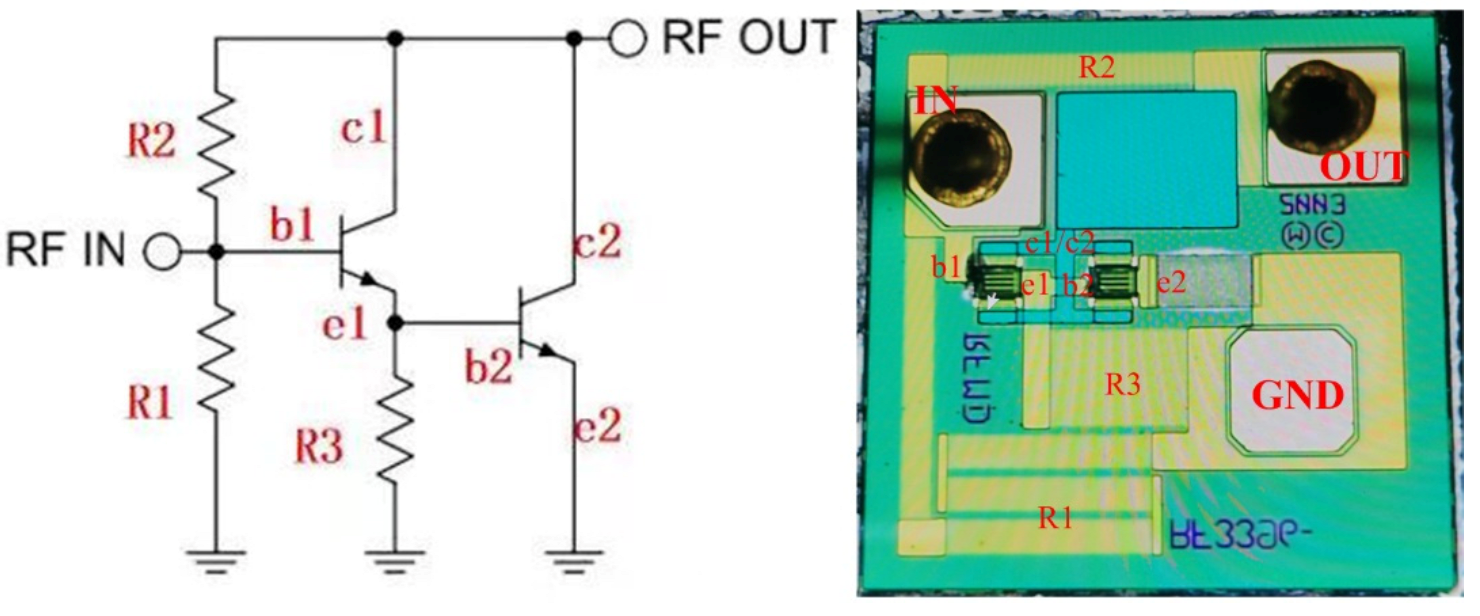
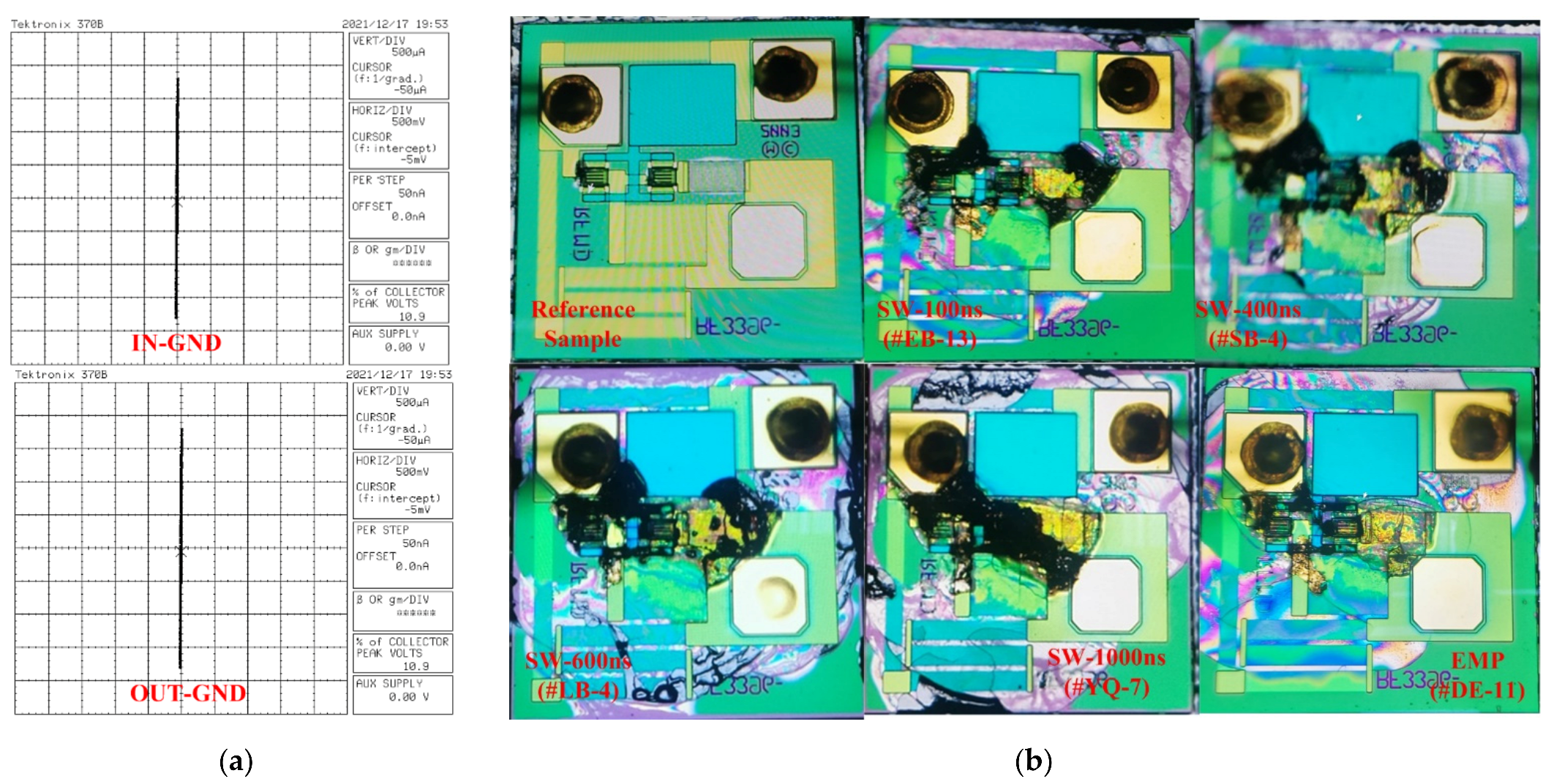
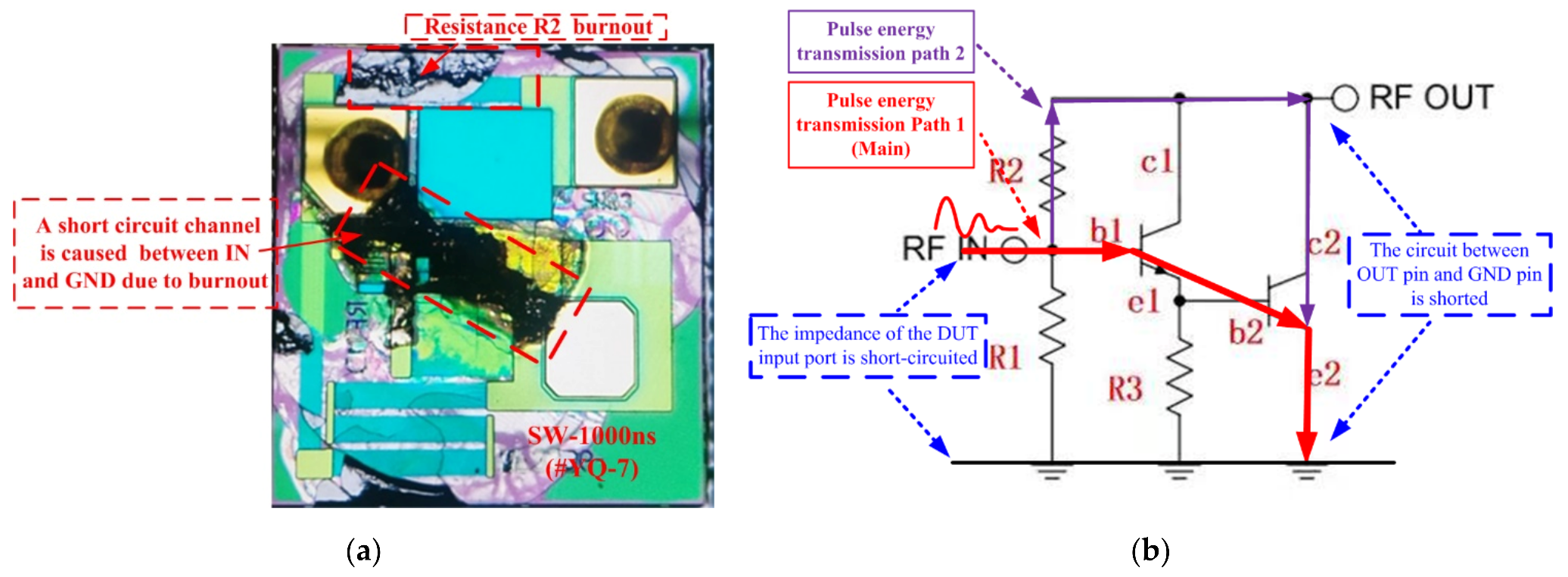
| Injected Wave Parameter | Voltage Rank (V) | Injected Current Peak (A) | Load Current Peak (A) | Sample ID |
|---|---|---|---|---|
| Square wave Pulse width 100 ns | 1200 | 41.4 | 1.6 | #EB-13 |
| Square wave Pulse width 400 ns | 1000 | 34.2 | 1.0 | #SB-4 |
| Square wave Pulse width 600 ns | 1000 | 35.0 | 1.0 | #LB-4 |
| Square wave Pulse width 1000 ns | 900 | 31.2 | 1.0 | #YQ-7 |
| EMP 20 ns/500 ns | 1400 | 23.6 | 0.7 | #DE-11 |
| P-Norms | Mathematical Expression | f(t) | Physical Meaning | Application |
|---|---|---|---|---|
| 2 | Electric field, magnetic field, voltage, current | Root of energy flow | Device is burnout due to overheat | |
| Electric field, magnetic field, voltage, current | Peak value (absolute) | Digital circuit flip, switch or dielectric breakdown etc. |
Publisher’s Note: MDPI stays neutral with regard to jurisdictional claims in published maps and institutional affiliations. |
© 2022 by the authors. Licensee MDPI, Basel, Switzerland. This article is an open access article distributed under the terms and conditions of the Creative Commons Attribution (CC BY) license (https://creativecommons.org/licenses/by/4.0/).
Share and Cite
Du, C.; Xia, D.; Huang, Q.; Mao, C.; Cui, Z.; Fang, W.; Nie, X. Research on Electromagnetic Susceptibility of Electronic Modules in Component-Level HEMP PCI Test. Energies 2022, 15, 1409. https://doi.org/10.3390/en15041409
Du C, Xia D, Huang Q, Mao C, Cui Z, Fang W, Nie X. Research on Electromagnetic Susceptibility of Electronic Modules in Component-Level HEMP PCI Test. Energies. 2022; 15(4):1409. https://doi.org/10.3390/en15041409
Chicago/Turabian StyleDu, Chuanbao, Dewei Xia, Quan Huang, Congguang Mao, Zhitong Cui, Wenxiao Fang, and Xin Nie. 2022. "Research on Electromagnetic Susceptibility of Electronic Modules in Component-Level HEMP PCI Test" Energies 15, no. 4: 1409. https://doi.org/10.3390/en15041409
APA StyleDu, C., Xia, D., Huang, Q., Mao, C., Cui, Z., Fang, W., & Nie, X. (2022). Research on Electromagnetic Susceptibility of Electronic Modules in Component-Level HEMP PCI Test. Energies, 15(4), 1409. https://doi.org/10.3390/en15041409





